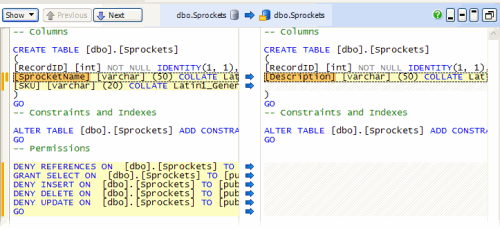Viewing the SQL differences
Published 19 June 2013
The lower (SQL Differences) pane displays a side-by-side listing of differences in the creation SQL script for an object. To display the SQL Differences pane, click an object in the upper (Results) pane.
You can adjust the height of the SQL Differences by dragging it up or down, or by using the buttons to move the pane to a fixed height.
Click to open the SQL Differences pane in a separate window.
Viewing differences
Lines that contain differences are displayed with a shaded background; text within a line that is different is displayed with a darker shaded background.
The central column shows the type of difference:
there are differences in the group of SQL statements | |
this line of SQL will be added if you synchronize this object (the direction of the arrow indicates the database that will be updated) | |
this line of SQL will be added if you synchronize this object (the direction of the arrow indicates the database that will be updated) | |
this line of SQL will be removed if you synchronize this object |
There is no icon if the two lines are identical.
Use Next and Previous to go to lines that contain a difference. You can also use Alt + Up Arrow and Alt + Down Arrow.
The Line Differences bar
Click and select Line Differences to display the Line Differences bar. The two versions of the line are shown one on top of the other. This is especially useful when the lines are too long to view all the text:
Scroll bar
Colored blocks in the left scroll bar indicate the location in the script of lines that are different.
Searching and copying the creation script
To search the SQL statements, right-click, and click Find.
To search the SQL statements in the other data source, click Find on this side.
The search is not case-sensitive.
Viewing the object synchronization script
To view the synchronization script for the selected object, right-click in the SQL Differences pane, and then click Show Object synchronization Script.
The Single Object synchronization Script dialog box is displayed.
You are recommended to synchronize only using the full synchronization script created by the synchronization wizard, because the single objects script cannot account for dependencies. If you use the object synchronization script to synchronize a single object, there may be unexpected results, or the synchronization may fail.
To view the full synchronization script that will make the two databases identical, use the synchronization wizard.














